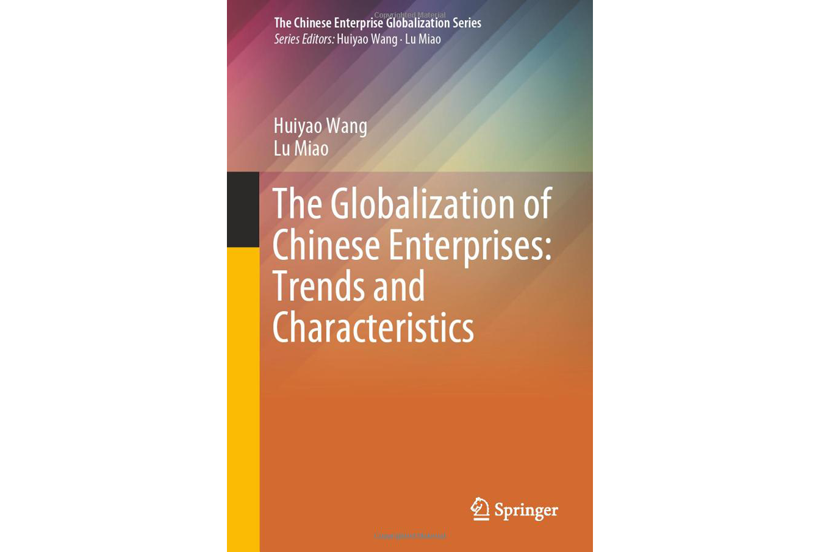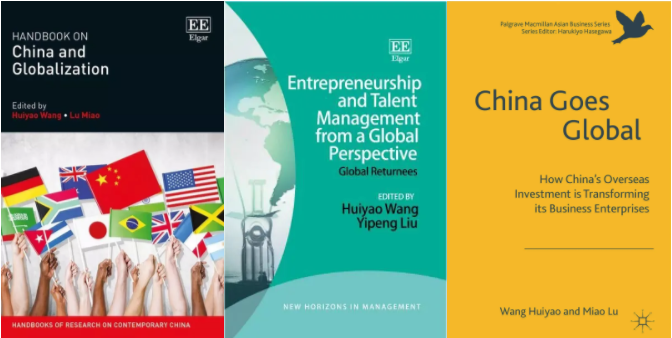CCG Releases New Book: The Globalization of Chinese Enterprises
July 14 , 2020

The internationalization of Chinese enterprises is one of the most notable aspects of economic globalization in the 21st century. Despite the 2008 financial crisis and weak global outbound investment, under the “go global“ initiative, Chinese outbound investment has gone from strength to strength, while also diversifying in terms of investment modalities, destinations, and industries. However, growing anti-globalization sentiment in some countries has also created new challenges for Chinese enterprises expanding internationally.
Recently, the Center for China and Globalization (CCG) released its new book The Globalization of Chinese Enterprises: Trends and Characteristics, written by CCG President Dr. Wang Huiyao and CCG Secretary-General Dr. Miao Lu. This book was published by Springer and draws on nearly 3000 data samples, using both quantitative and qualitative research methods. This book investigates challenges confronted by Chinese enterprises when doing business in foreign countries, presents unique insights into the features and patterns of Chinese enterprises’ globalization, and provides a useful reference for enterprises that have already gone global and those that plan to.
The book summarizes research covering three angles, namely: the current situation, causation analysis and corresponding solutions, and recommendations for firms, government agencies and other institutions.
Chapter One studies the current trend and features of outbound investment worldwide. The book shows that 2017 saw both the global economy and global trade grow at the fastest rate since 2011, with growth of 3% and 4.7% respectively. By contrast, outbound investment decreased worldwide in 2016 and 2017. For instance, in 2017, cross-border mergers and acquisitions (M&A) and announced greenfield investments decreased by 22% and 14% respectively. In addition, levels of investment in developed countries shifted drastically, while levels of investment in developing countries remained stable and robust. Generally speaking, international investment policies are becoming more liberalized and supportive, but protectionist measures adopted by certain countries remain a cause for concern.
Chapter Two analyses the current trends and features of China’s outward foreign direct investment (OFDI). The book points out that, despite rising trade barriers and the trend of anti-globalization, China’s economy continues to grow and develop. According to the National Bureau of Statistics, in 2017, China’s GDP broke the CNY 80 trillion mark for the first time, reaching CNY 82.7 trillion. The growth rate of 6.9% was higher than 2016, the first increase in seven years. Although Chinese enterprises’ OFDI slowed, investment fields and patterns stabilized. At the same time, investments diversified and broadened in scope, with particular success along the Belt and Road.
Chapter Three focuses on problems faced by globalizing Chinese enterprises and proposed solutions. The book points out that, as the “go global” movement accelerates, Chinese enterprises have encountered various problems in the process of globalization. These problems include insufficient ability to manage risks, such those stemming from law and politics; low levels of participation in the formulation of international standards; barriers to corporate brand internationalization strategy; and the limited internationalization of corporate talent. To help address these problems, this chapter maps out the current situation and challenges in each area, presents causal analysis, and proposes solutions accordingly. Additionally, the book shows statistics on outbound Investment by 879 Chinese enterprises between 2016 and 2017.
Preface
Foreword One
Foreword Two
Chapter 1 Current trends and features of outbound investment worldwide
1.1 Outline
1.2 The current situation and features of outbound investment worldwide
1.2.1 The largest drop in global FDI levels in recent years
1.2.2 FDI flows to developed economies fluctuated but flows to developing economies remained stable
1.2.3 Cross-border M&A and greenfield investment
1.2.4 International policy trends toward liberalization and investment facilitation
Chapter 2 Current Trends and Features of China’s OFDI
2.1 China’s OFDI decreases for the first time as policies rationalize the go-global movement
2.2 OFDI destinations diversify, with rapid growth in Europe and Africa
2.3 China’s OFDI covers many sectors, with particular increases in manufacturing, wholesale and retail, and finance
2.4 Overseas M&As by Chinese enterprises grow but fluctuate
2.5 Participation in the BRI by Chinese firms benefitted host countries
Chapter 3 Problems Faced by Globalizing Chinese Enterprises and Proposed Solutions
3.1 Legal Risks
3.1.1 Current situation: Enterprises “going global” face high legal risk and often rely on poor local legal services
3.1.2 Causal analysis: Lack of corporate legal awareness and insufficient international legal talent
3.1.3 Suggested Solutions
3.2 Political Risk
3.2.1 Current situation: Increasing frequency of geopolitical incidents and damage to overseas corporate interests
3.2.2 Causal analysis: Lack of preparatory intelligence gathering and an imperfect system of protective policies
3.2.3 Suggested solutions
3.3 Chinese investment in the US under the China-US trade issues
3.3.1 Current situation: Problems facing Chinese investment in the US under the China-US trade Issues
3.3.2 Causal analysis: Structural problems caused by rapid development of the global economy, skewing of China-US trade deficit under traditional statistical methods, and changes in domestic and international politics
3.3.3 Suggested Solutions
3.4 International Standard Setting
3.4.1 Current situation: Low-level of involvement in international standard setting
3.4.2 Causal analysis: Insufficient talent, technology and funding lead to weaknesses in the content and translation of standards
3.4.3 Suggested solutions
3.5 Internationalization of Chinese brands
3.5.1 Current situation: Chinese brand internationalization strategies face obstacles
3.5.2 Causal analysis: Lack of brand awareness, association and strategy
3.5.3 Suggested solutions
3.6 Talent Internationalization
3.6.1 Current situation: Chinese enterprises lack international talent
3.6.2 Causal analysis: Weak human resources management and cultivation
3.6.3 Suggested solutions
3.7 Enterprise Compliance
3.7.1 Current situation: Compliance is a critical component of Chinese enterprises’ internationalization
3.7.2 Causal analysis: Chinese enterprises are not familiar with overseas laws and take risks without having the necessary compliance mechanisms in place
3.7.3 Suggested solutions
Appendixes

CCG has long been committed to the research of global enterprise and global migration, and is a pioneer and promoter of globalization in China. Since its establishment, CCG has published many books on such issues with international publishers, such as Springer, Edward Elgar, and Palgrave Macmillian. The books published include Handbook on China & Globalization, China Goes Global, and Entrepreneurship and Talent Management From a Global Perspectives. Since entering the new era of “Globalization 4.0”, CCG has paid much attention to the new trend of “enterprise globalization.” This book provides a comprehensive overview of this trend, helps readers grasp the overall situation of China’s enterprises’ international expansion, and has important reference value for enterprises to formulate foreign investment strategies, grasp opportunities and meet challenges in the process of globalization.






